Cordlife Philippines: Frequently Asked Questions about Stem Cell Banking

Cordlife Philippines: Frequently Asked Questions about Stem Cell Banking
You've probably heard about cord blood banking and/or umbilical cord stem cell banking and may be curious about learning more. What does it really mean to collect and store the stem cells, and why are more Filipino families choosing Cordlife Philippines?
We’ll answer your top questions and help you understand how Cordlife offers an unparalleled level of security, expertise, and innovation in stem cell banking.
1. What is Cord Blood and Why is it Valuable?
Cord blood is the blood collected from your baby’s umbilical cord after birth. It’s rich in hematopoietic stem cells (HSCs)--the same type of stem cells used in bone marrow transplants.
These stem cells can potentially treat over 80 life-threatening diseases such as leukemia, thalassemia, and certain immune and metabolic disorders. Clinical trials are also exploring their potential in regenerative medicine, such as treating cerebral palsy and autism.
2. What is Umbilical Cord Stem Cell Banking?
Umbilical Cord Stem Cell Banking is the process of collecting, processing, and storing stem cells from the umbilical cord of a baby for future medical use. When you choose cord blood banking, you’re preserving your child’s valuable biological resource--one that’s a perfect match for them and possibly for the siblings or family members.
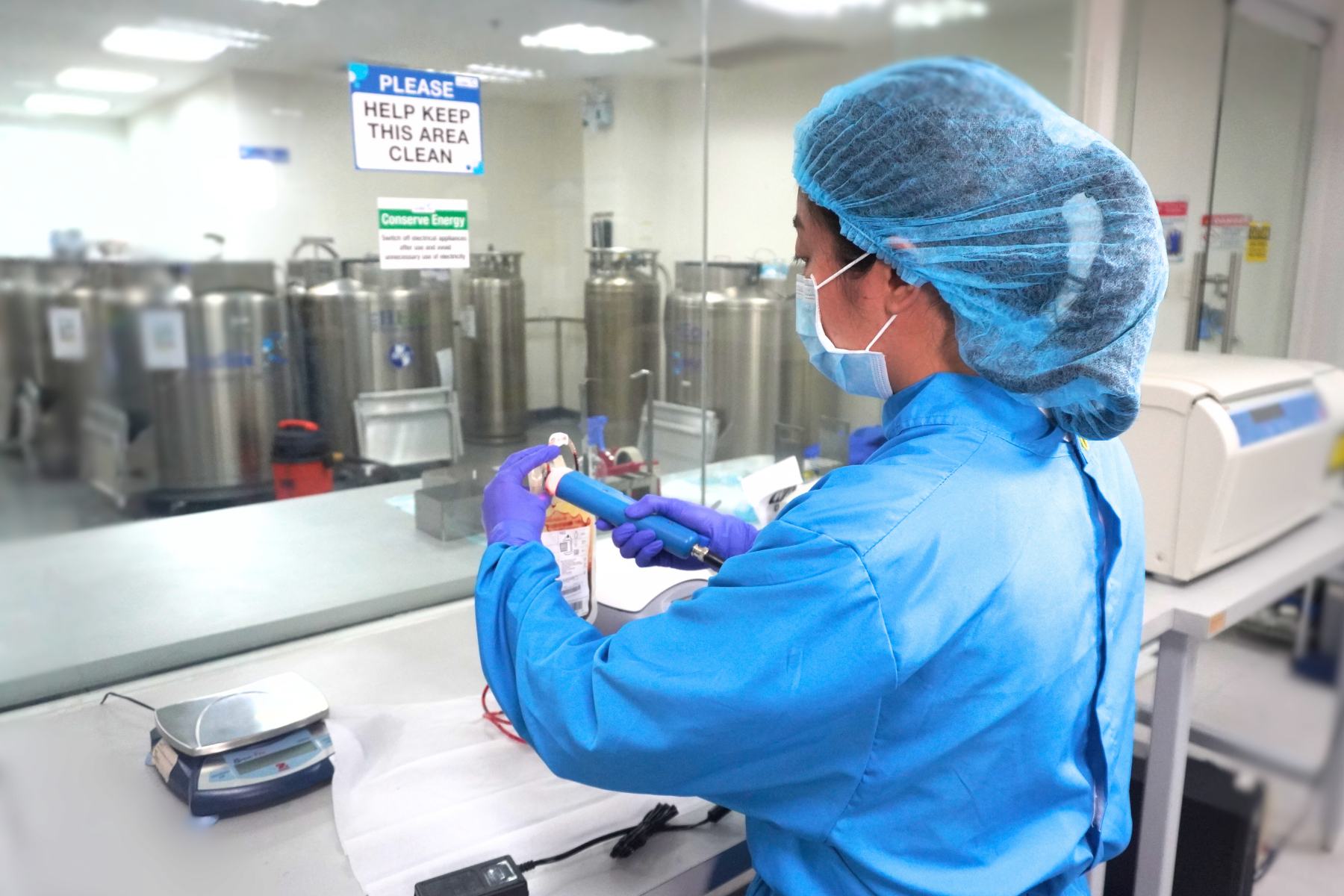
3. Why Choose Cordlife Philippines for Umbilical Cord Stem Cell Banking?
Cordlife Philippines is part of the largest network of private cord blood banks in Asia, and the group it belongs to has over 20 years of experience. Here are other things that set Cordlife Phlippines apart:
a. ISO-Certified and AABB-accredited
Cordlife Philippines is the first and only ISO 9001:2015-certified and AABB-accredited (Association for the Advancement of Blood and Biotherapies) facility in the country.
Being AABB-accredited means that cord blood released from our facility adheres to the highest global standards and stringent requirements for cellular therapy. Major therapy centers both here and abroad will require cord blood units from accredited facilities only.
b. 24/7 Real-Time Laboratory Monitoring System
Cordlife Philippines has 24/7 real-time monitoring of its storage facility, onsite and remotely, providing round-the-clock protection of your child’s stem cells.
c. Licensed Trained and Completent Biotechnologists
Only licensed medical technologists and biotechnologists handle your baby’s cord blood sample.
Cordlife Philippines biotechnologists are highly trained and skilled in stem cell processing, testing, and storage. Before handling actual samples, they undergo a rigorous training & exercise period of four months to ensure proper sample management. This training is further reinforced through annual competency assessments and continuous education, keeping them updated on the latest advancements and best practices.
d. Over 20,000 Filipino Parents Have Chosen Cordlife
Since it started its local operations, there have already been more than 20,000 Filipino Parents who have entrusted their baby’s stem cells with Cordlife Philippines
4. How is Cord Blood Collected? Is it Safe?
Yes, collecting cord blood is safe, quick, and painless for both mother and baby. After your baby is born and the umbilical cord is clamped and cut, your OB-GYN or trained medical practitioner or delivery room staff will collect the remaining blood in the cord using a sterile kit provided by Cordlife Philippines.
5. How Long Can Cord Blood Be Stored?
Studies suggest that under certain cryogenic conditions such as using liquid nitrogen and keeping the temperature at or below -150°C, cord blood stem cells can be stored indefinitely and remain viable*.
The Estimated shelf life in cryopreserved state: 1,000 years**
* Liedtke S, Tobben S, Holger G, et.al. Long-term stability of cord blood units after 29 years of cryopreservation: follow-up data from the Jose Carreras cord blood bank. Stem Cells Translational Medicine. 2023; XX (1-13). DOI: https://doi.org/10.1093/stcltm/szad071.
** Karlsson J, Toner M. Long-term storage of tissues by cryopreservation: critical issues. Biomaterials. 1996; 17(3): 243-256.
6. Can Cord Blood Be Used by Other Family Members?
Yes, cord blood may be used not only by your baby or the owner of the cord blood, there’s a high chance of a match between siblings, and since each child is genetically unique, banking for each child ensures each has their own perfect match while also increasing the chances of a suitable match within the family, which is why many parents choose to bank cord blood for each child.
*For other types of stem cells found in the cord lining and cord tissue, matching is potentially unnecessary, making it useful for other family members.

7. How Do I Enroll with Cordlife Philippines?
The process is simple:
- Schedule a Free Consultation with our Client Relationship Executives – Learn more about your options.
- Enrollment – Choose the right banking plan for your family and sign up thereafter
- Get Your Personalized Collection Kit – This kit will have to be brought to the hospital and endorsed to your OB-GYN or the delivery room staff when you give birth.
- Collection and Transport – Cordlife Philippines’ team picks up the sample within 24 hours after collection.
- Processing and Storage – Your baby’s cord blood is processed and safely stored in Cordlife’s high-security cryogenic facility.
Choosing to bank your baby’s cord blood is a once-in-a-lifetime decision. With Cordlife Philippines, you gain a trusted partner dedicated to helping protect your family’s future through world-class stem cell banking services.
To learn more or schedule a consultation, visit www.cordlife.ph/make-an-appointment and find out about our ongoing promotions.
Learn more about stem cell banking today
Unlock essential knowledge about umbilical cord stem cell banking and be more prepared for the arrival of your little one with Cordlife Philippines' Information Pack.
Recent Blog Posts
- 24 October 2025
- 24 October 2025
- 21 October 2025
- 09 September 2025
- 20 August 2025
Cordlife Philippines Earns Back-to-Back AABB reaccreditation and ISO recertification

Cordlife Philippines Earns Back-to-Back AABB reaccreditation and ISO recertification
We’re proud to share that Cordlife Philippines has once again achieved AABB reaccreditation and ISO 9001:2015 recertification, a testament to our unwavering commitment to world-class stem cell banking services.

The AABB (Association for the Advancement of Blood and Biotherapies) accreditation recognizes excellence in cellular therapy services. This international gold standard confirms that our quality and operational systems meet and even exceed the rigorous requirements set by the AABB Standards Committees.

Meanwhile, the ISO 9001:2015 certification from SGS highlights our consistent ability to deliver products and services that meet both customer expectations and strict regulatory requirements, backed by a strong quality management system.

With these recognitions, Cordlife Philippines remains the first and only cord blood bank in the country to hold both prestigious credentials, a distinction we’ve proudly maintained since 2017 for AABB and 2012 for ISO.
For every family we serve, these seals are more than just certificates. They are our promise to provide the highest standards of service, processing, and long-term storage for your child’s umbilical cord blood stem cells – today and for years to come.
Learn more about stem cell banking today
Unlock essential knowledge about umbilical cord stem cell banking and be more prepared for the arrival of your little one with Cordlife Philippines' Information Pack.
Recent Blog Posts
- 24 October 2025
- 24 October 2025
- 21 October 2025
- 09 September 2025
- 20 August 2025
Unang Yakap and Stem Cell Banking: A Healthy Start from Day One
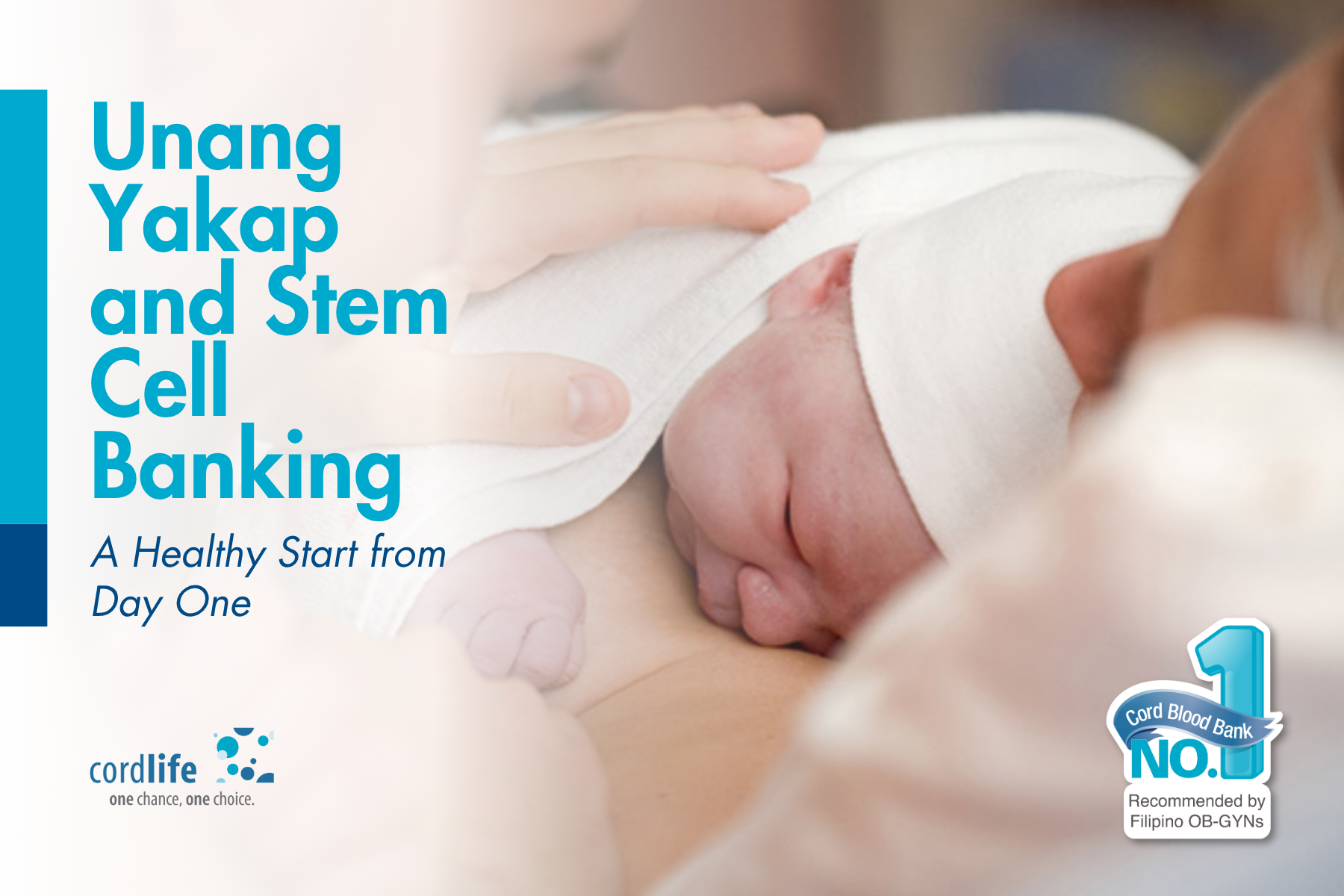
Unang Yakap and Stem Cell Banking: A Healthy Start from Day One
Happy Breastfeeding Month! Pregnant and looking to explore more ways to give your baby the best start in life? Read on to see two important and meaningful practices that offer care and protection from your baby starting from day one.
For parents, every decision, starting from the delivery room to the first latch, can feel overwhelming but deeply meaningful. Two practices that stand out in providing babies with the best possible start in life are Unang Yakap (The First Embrace) and Stem Cell Banking. Though different in process, both offer lasting benefits rooted in early care.
What is Unang Yakap?

Unang Yakap, or “The First Embrace,” is part of the Essential Intrapartum and Newborn Care (EINC) recommended by the Department of Health (DOH), Philippine Health Insurance Corporation (PhilHealth), and World Health Organization (WHO)1. It highlights simple yet evidence-based steps immediately after birth that may help ensure the survival of newborns and young infants:
- Immediate drying of the baby
- Skin-to-skin contact between mom and baby
- Proper umbilical cord clamping and cutting
- Non-separation of the baby from the mother and initiation of breastfeeding
These steps are proven to regulate the newborn’s body temperature, improve breathing, and foster early breastfeeding, which can help build immunity and emotional bonding. There are also several benefits that it can provide to the mother as well. Please keep in mind that the Unang Yakap campaign or EINC protocol should be followed in order to ensure the health of both the mother and the baby2
What is Stem Cell Banking?

Stem cell banking involves the collection, processing, and preservation of the stem cells from the umbilical cord blood or tissue right after birth of the baby. These stem cells are valuable because they may be used to potentially treat over 80 diseases3 like:
- Blood cancers such as various types of leukemia3
- Blood disorders such as aplastic anemia and beta thalassemia major3
- And in recent years, they’ve also been studied for their potential in regenerative medicine, such as autism, cerebral palsy, diabetes, and ischemic stroke, among others4,5
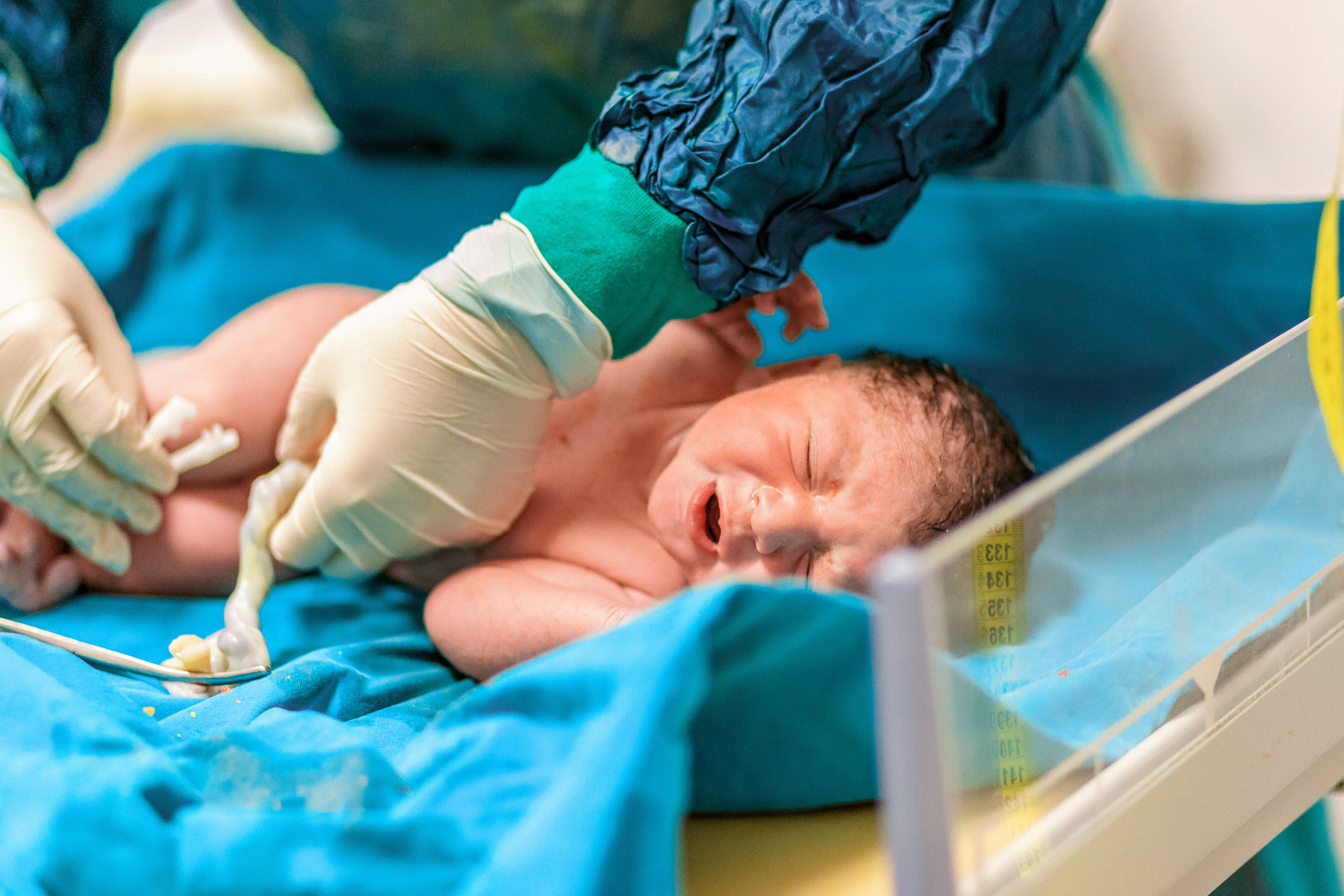
The collection process is quick, safe, and painless, and it happens after the umbilical cord is clamped6, so it doesn’t interfere with Unang Yakap at all.
Important note: Enrollment in stem cell banking can be done as early as the first trimester, with benefits like pregnancy insurance that can give coverage for the mother from 7 types of pregnancy complications as early as 18 weeks of pregnancy.
Planning Ahead with Your OB-GYN
Whether it’s ensuring Unang Yakap happens or deciding to bank your baby’s cord blood and cord tissue, preparing a birth plan is a great way to make your preferences known. It helps clarify your priorities and communicating them to your OB-GYN, and makes you feel empowered and at ease during labor and delivery.
Talk openly with your OB-GYN about your birth plan early on, and let them know if you're considering stem cell banking. Your medical team plays a key role in coordinating both practices safely and smoothly.
While Unang Yakap is focused on immediate health and bonding, stem cell banking offers long-term protection that may be helpful in the future. Both are anchored in the idea of prevention, preparation, and care. Unang Yakap supports survival and healthy development in the newborn’s first hours through the infancy stage, while stem cell banking provides health protection options for you and your baby later in life.
Unang Yakap and stem cell banking represent evolving ways we care for our children, from the very first touch to preparing for life’s uncertainties.
Whether you’re still exploring your options or already mapping out your birth plan, it helps to know that these steps can work hand-in-hand to give your baby the healthiest start possible.
References
- https://caro.doh.gov.ph/wp-content/uploads/2014/09/EINC.pdf
- https://nnc.gov.ph/luzon-region/newborn-care-unang-yakap-and-newborn-screening/
- Diseases treated page. Parent’s Guide to Cord Blood Foundation. https://parentsguidecordblood.org/en/diseases. Accessed August 04, 2025.
- Potential Future Uses in Regenerative Medicine. Cord Blood Registry Website. https://www.cordblood.com/science-in-action. Accessed August 04, 2025.
- Clinical trial registry page. ClinicalTrials.gov. http://clinicaltrials.gov. Accessed August 04, 2025.
- https://www.cordlife.ph/en/collection-process
Learn more about stem cell banking today
Unlock essential knowledge about umbilical cord stem cell banking and be more prepared for the arrival of your little one with Cordlife Philippines' Information Pack.
Recent Blog Posts
- 24 October 2025
- 24 October 2025
- 21 October 2025
- 09 September 2025
- 20 August 2025
Father’s Role in Family Health Decisions: Stem Cell Banking from a Father’s Perspective
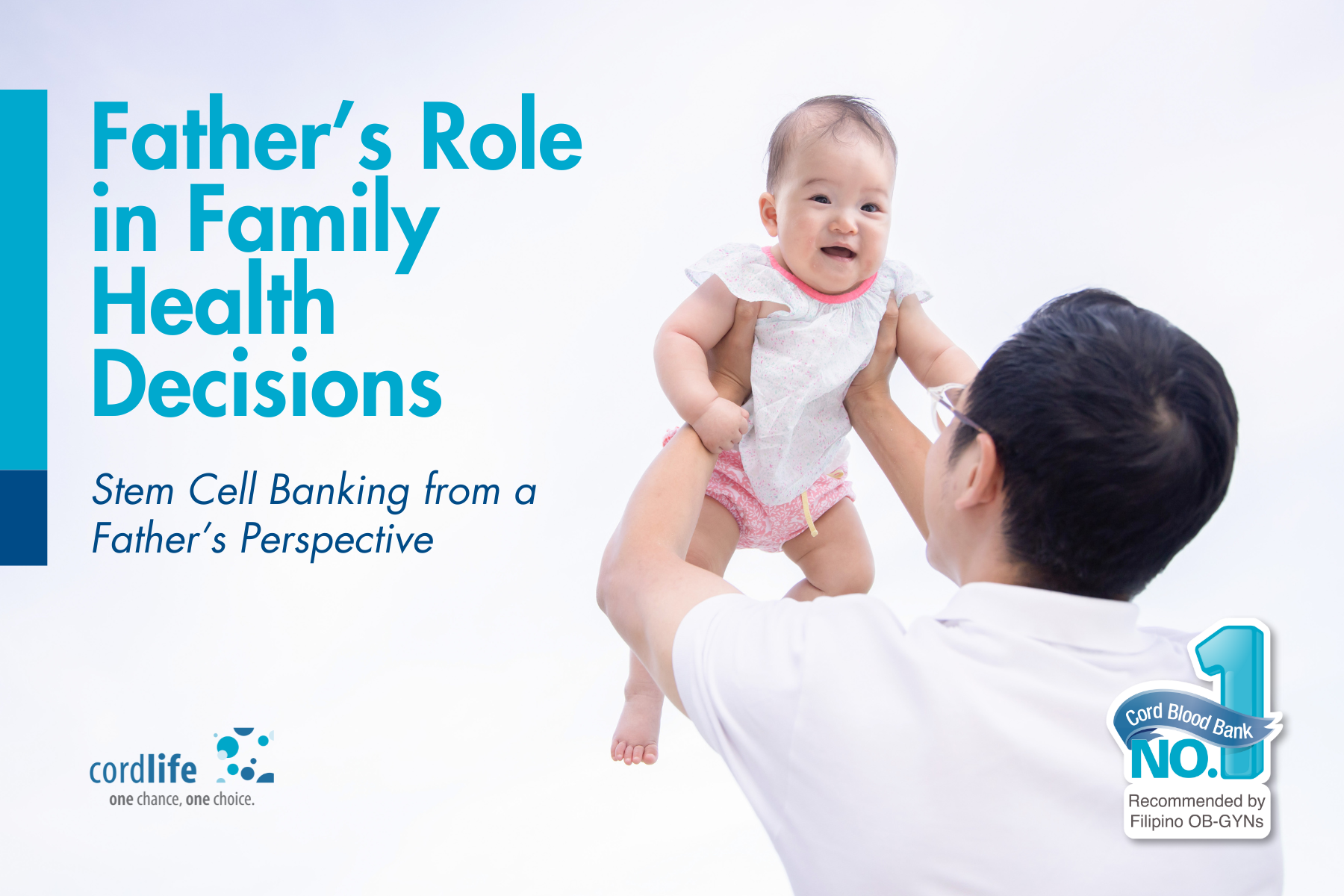
Father’s Role in Family Health Decisions: Stem Cell Banking from a Father’s Perspective
Gone are the days when health decisions related to pregnancy and family were considered solely the mother’s domain. Today’s modern dads are taking a more active, empowered role in shaping their family’s health and future- and it’s a shift worth celebrating, especially this Father's Month.
From helping set up the nursery to budgeting for future schooling, dads have increasingly stepped up to ensure every base is covered for their growing families. One powerful decision that’s gaining more attention among forward-thinking parents is umbilical cord stem cell banking.
“I Want to Be Sure We’ve Thought of Everything”
For many dads, becoming a parent suddenly gives them a strong sense of responsibility to provide and protect. And that protection now extends beyond the physical and financial - into the realm of health security.
It's a way to give their little one and potentially even themselves, a medical advantage in the future.
At Cordlife Philippines, we’ve seen more and more fathers take the initiative to learn about how cord blood and cord tissue stem cells can be stored and used for various conditions in the future. Cord blood has been proven to potentially treat over 80 critical illnesses, including blood cancers such as leukemia and blood disorders like thalassemia. Meanwhile, cord tissue holds promise in regenerative medicine, with ongoing studies and applications in the treatment of stroke, cardiovascular diseases, neurodegenerative disorders, and many more.
Teamwork in Decision-Making
Most dads will agree: parenting is a partnership. From choosing the right OB-GYN to selecting the right baby gear, every big decision is best made together. Stem cell banking is no different.
Many fathers say they initially came across the concept through a seminar or a quick chat with their partner. But after doing their own research and attending consultations with Cordlife Philippines, they realized the need to learn about it for the entire family's benefit.
Together, couples weigh the value of securing their child’s future health, often seeing stem cell banking as a way of preparing for the unknown. It becomes a shared commitment—a powerful gesture of love and protection for the family.
Dads Benefit, Too!
What’s often not talked about enough is that Cordlife Philippines’ umbilical cord blood banking doesn’t just safeguard the baby. Through value-added benefits such as Transplant Care transplant financial assistance, even dads can be covered in certain medical conditions involving approved stem cell treatments.

Another value-added service is the Cordlife ALLIANCE Program which lets you enjoy benefits such as unlimited sample search, access to a genetically diverse member pool, and entitlement to reimbursement in case you want to help another family in need with your baby’s cord blood.
Other value-added benefits are available for the comprehensive care not just of the baby but the entire family as well.
Terms and conditions apply.
Looking Ahead with Confidence
Being a dad today means being a planner, a protector, and an equal partner. It means thinking not just about the now, but about the ‘what ifs’. Stem cell banking, from a father’s perspective, isn’t just about science—it’s about peace of mind.
As we honor dads this month, let’s celebrate those who are proactive in their parenting, those who ask the hard questions, and those who choose to future-proof their family’s health in every way they can.

Curious about how Cordlife can support your family's health goals?
Learn more about our family-inclusive benefits and talk to one of our consultants today when you book a free consultation.
Recent Blog Posts
- 24 October 2025
- 24 October 2025
- 21 October 2025
- 09 September 2025
- 20 August 2025
The Best Decision Moms Made for Their Baby’s Future: Banking Stem Cells with Cordlife
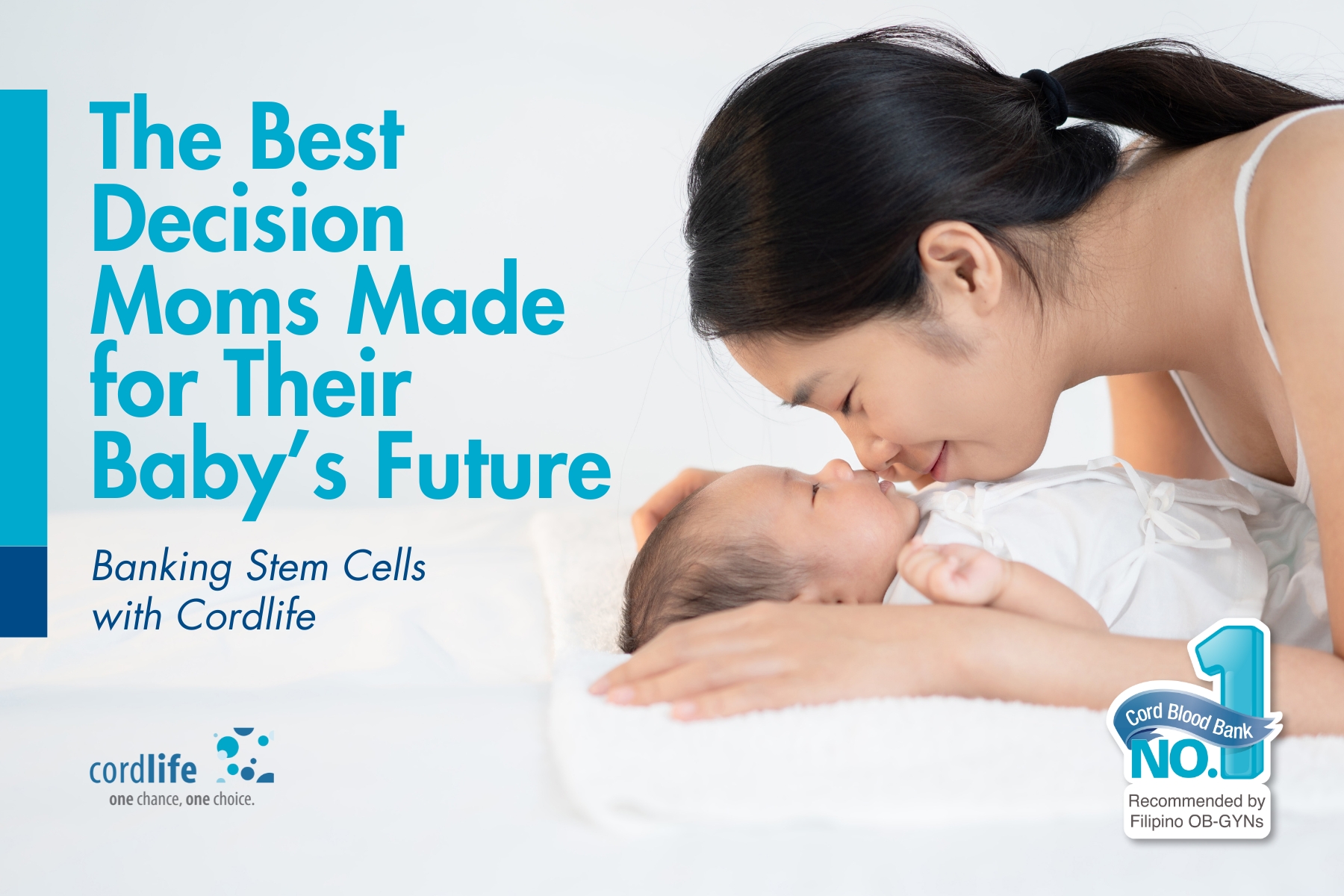
The Best Decision Moms Made for Their Baby’s Future: Banking Stem Cells with Cordlife
When you become a parent, every decision feels monumental - especially the ones that make an impact on your child’s future. For many Filipino moms, choosing to bank their baby’s cord blood, cord lining, and cord tissue stem cells with Cordlife Philippines isn’t just a practical choice but an investment that provides peace of mind and medical readiness.
A Lifeline That Lasts
Cord blood is rich in stem cells that are currently used to treat over 80 diseases, including certain cancers, blood disorders, and immune deficiencies. Cord tissue, on the other hand, holds great potential in regenerative medicine, with ongoing studies for conditions like cerebral palsy, stroke, and cardiovascular diseases. With advancements in medicine, the possibilities just continue to grow, offering hope not only for your child but possibly for other family members, too.
By choosing to preserve their baby’s stem cells, Cordlife moms secured a biological safety net that could one day make a life-changing difference.
Real Stories, Real Impact
Cordlife has already made this promise real for families across Asia. To date, the Cordlife Group has successfully released 77 cord blood units- 2 of which were from the Philippines, and 21 cord tissue units, with 9 of them from the Philippines alone. These successful releases have helped families in actual medical treatments for conditions like leukemia and cerebral palsy.
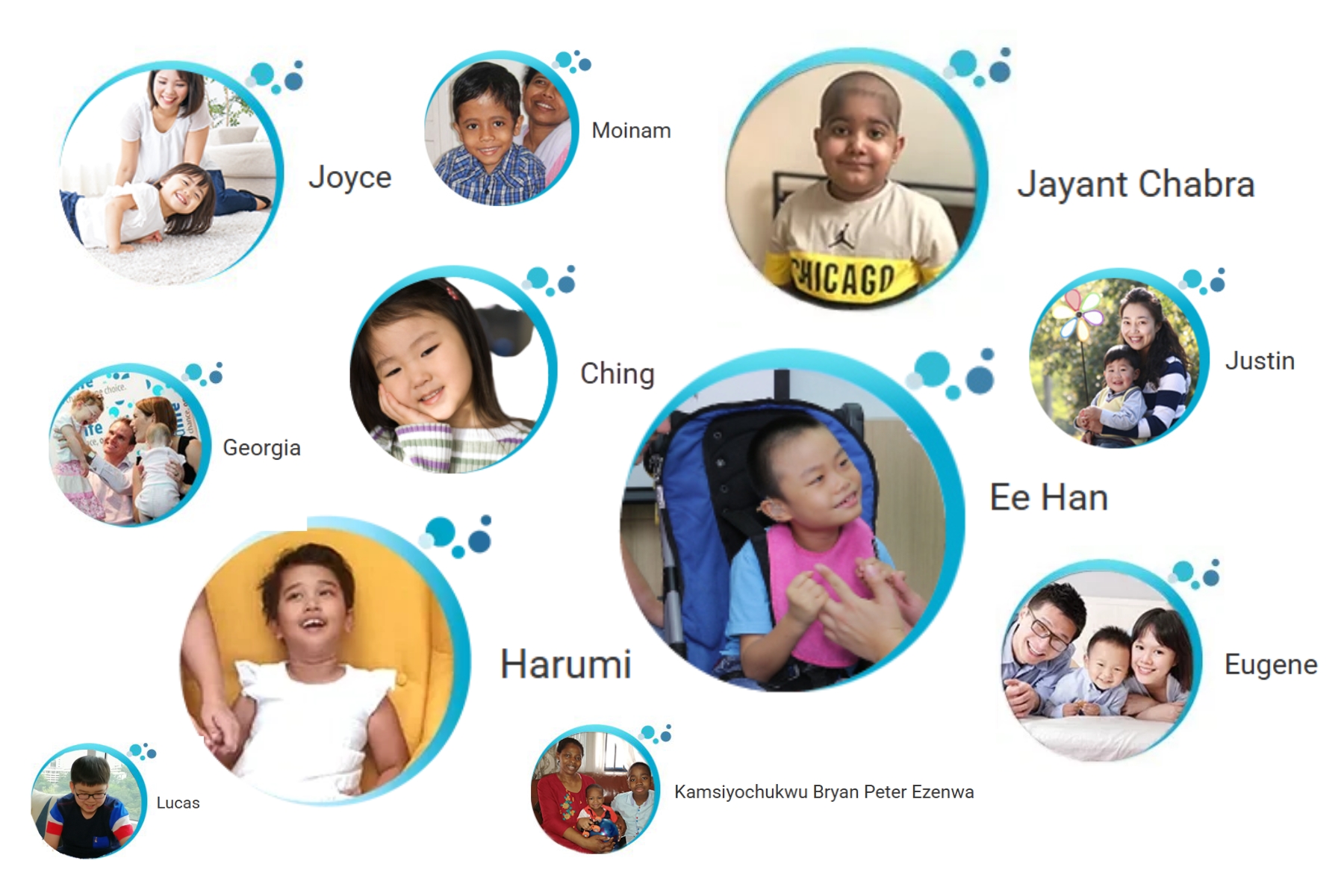

One such story is that of Eugene (not his real name), a young boy diagnosed with leukemia. Doctors gave him only a 10% chance of recovery without a bone marrow transplant. Unfortunately, neither of his parents were a match, and as an only child, the odds of finding a non-related donor were slim. Determined to save their son, Eugene's parents decided to conceive a second child and bank the baby's cord blood with Cordlife. Miraculously, the newborn's cord blood was a 100% match for Eugene. The stem cell transplant was successful, and today, Eugene is thriving and enjoying school. His mother's reflection says it all: “The decision to collect his sister’s cord blood was the right one.”
These are not just numbers- they are stories of hope, second chances, and the power of proactive parenting.
Trusted by Thousands, Backed by Science
Cordlife is more than just a storage facility. It’s a network of professionals committed to world-class care, safety, and innovation. As part of the Cordlife Group, Cordlife Philippines benefits from the latest technology and a global standard of excellence. Every release adds to a growing track record of credibility and capability:
Making the Right Choice This Special Month of Mothers
To every mom who chose Cordlife, your decision is saying Yes to preparedness. Yes to Peace of Mind. Yes to your child’s tomorrow.
And if you’re still deciding? Know this: the best time to secure your baby’s future is now.
Learn more about our Mother’s Month Specials this Month of May!

Download Info Pack: P5,000 PAL Vouchers to 5 lucky downloaders!

Book an Appointment, and when you enroll, get P5,000 eGift as a Sign-up Bonus!
Recent Blog Posts
- 24 October 2025
- 24 October 2025
- 21 October 2025
- 09 September 2025
- 20 August 2025
Cordlife Philippines: The #1 Recommended Cord Blood Bank by Filipino OB-GYNs

Cordlife Philippines: The #1 Recommended Cord Blood Bank by Filipino OB-GYNs
When it comes to securing your baby’s future health, trust is everything. That’s why we are pleased to share that Cordlife Philippines has been recognized as the #1 recommended cord blood bank by Filipino OB-GYNs in the Philippines. This is based on a survey conducted at the Philippine Obstetrical and Gynecological Society (POGS) Annual Convention at the Philippine International Convention Center (PICC) in November 2024.
Since our launch in 2009, Cordlife Philippines has remained the leading brand in cord blood banking, consistently setting the standard for quality, innovation, and reliability. With over 20,000 Filipino parents entrusting their children’s stem cells with us, we take this recognition as a reaffirmation of our commitment to providing stem cell banking services with utmost care.
Why Parents and Doctors Choose Cordlife
Our position as the most recommended cord blood bank is built on years of dedication to excellence. Is Cordlife worth it? Here are reasons why families and medical professionals continue to choose Cordlife Philippines:
- Proven Track Record: With over 15 years of experience in cord blood, cord tissue, cord lining, and mesenchymal stem cell banking - serving thousands of Filipino families.
- Certifications and Accreditations: Cordlife Philippines has been consistently ISO 9001-certified since 2012 and AABB-accredited since 2017, ensuring that our facility meets global standards in stem cell preservation.
- Safe and Secured Processing and Cryopreservation – Our facility boasts of a storage capacity of 30,000 stem cell units, the biggest in the country, which is being managed by highly qualified laboratory biotechnologists, ensuring round-the-clock monitoring and equipped with multiple safety and security systems to uphold the highest standards. This remains to be one of the top Cordlife advantages.
- Commitment to Families – We don’t just store stem cells; we provide peace of mind, knowing that they are well-preserved until the time they are needed. We also offer a comprehensive range of Cordlife benefits that come free* with our stem cell banking services including Cordlife Shield Pregnancy Insurance, Cordlife Transplant Care, and Cordlife ALLIANCE, Baby Genetic Screening, to name a few.
*Terms & conditions apply.
Protecting Your Baby’s Future
Earning the trust of parents and healthcare professionals alike is not just an achievement—it’s a responsibility. At Cordlife Philippines, we remain dedicated to our promise of safeguarding your baby’s precious stem cells, offering you confidence and security for the years ahead.
Thank you to all the Filipino families and medical experts who continue to put their faith in us. With Cordlife, you can always trust that you are making the #1 choice for your child’s health and future.
Want to know more?
Cordlife Philippines is dedicated to helping mothers and families make the most of this incredible advancement in medical science. Learn more about cord blood, cord tissue, cord lining, mesenchymal stem cell banking, and other Cordlife benefits and Cordlife advantages today.
Recent Blog Posts
- 24 October 2025
- 24 October 2025
- 21 October 2025
- 09 September 2025
- 20 August 2025
Understanding Non-Invasive Prenatal Testing (NIPT): A Guide for Expecting Parents

Understanding Non-Invasive Prenatal Testing (NIPT): A Guide for Expecting Parents
Becoming a parent is a life-changing experience filled with excitement and anticipation. As technology advances, so do the options available to soon-to-be parents, especially in the realm of prenatal testing.
One such development is Non-Invasive Prenatal Testing (NIPT). This blog article aims to provide expecting parents with a comprehensive understanding of NIPT as a screening service, its benefits, and considerations to make informed choices during their pregnancy journey.
What is Non-Invasive Prenatal Testing (NIPT)?
Non-Invasive Prenatal Testing or NIPT, is a cutting-edge screening test that focuses on analyzing the risks related to genetic conditions of the developing baby. It is done through a simple blood draw from the expecting mother as early as 10 weeks into the pregnancy, with little or no risk.
How Does NIPT Work?
NIPT relies on the analysis of cell-free DNA (cfDNA) circulating in the maternal bloodstream. During pregnancy, a small fraction of the DNA in the bloodstream comes from the placenta and the developing fetus. By isolating and analyzing this fetal DNA, NIPT can provide valuable information about the baby's genetic makeup.
Conditions Detected by NIPT
Non-invasive Prenatal Testing screens for the most common chromosomal abnormalities, including Down Syndrome (Trisomy 21), Edwards Syndrome (Trisomy 18), and Patau Syndrome (Trisomy 13). NIPT also screens for sex chromosome abnormalities like Turner syndrome and Klinefelter syndrome. With Cordlife NIPT, up to 142 conditions can be detected.
Advantages of NIPT
Non-invasive Prenatal Test poses no direct threat to the fetus or the mother and since it can be performed as early as 10th week of pregnancy, you can get early insights into your baby's health and be more prepared for their arrival. NIPT boasts high sensitivity and specificity rates, offering reliable results.
Another thing that parents love about NIPT is that it also provides the option to know the gender early.
Screening, Not Confirmatory
NIPT is a screening tool and does not provide definitive diagnostic results. Positive findings may require confirmation for diagnostic test.
Cordlife Philippines Non-invasive Prenatal Testing with free Chromosomal Microarray Analysis
Cordlife PH offers basic and comprehensive options for NIPT with its available plans: Lite, Premium, and Premium Plus. With Cordlife NIPT Premium Plus, high-risk patients can avail of free Chromosomal Microarray Analysis (CMA) diagnostic testing.
Cordlife NIPT Price
Cordlife NIPT price ranges from P21,500-P44,500 with a free genetic counseling session and the option to have a home service maternal blood extraction.
Non-Invasive Prenatal Testing is a safe, accurate, and convenient option for expectant parents to assess the risk of certain chromosomal abnormalities in their unborn child. Informed choices during pregnancy contribute to a healthier and more secure start for both parents and their precious new addition to the family. Ask your OB-GYN about NIPT today!

Recent Blog Posts
- 24 October 2025
- 24 October 2025
- 21 October 2025
- 09 September 2025
- 20 August 2025
Full month party ideas
Full month party ideas

A baby's full moon celebration is one of the most significant milestones that follow birth. If you are planning a full moon celebration for your baby, we hope this guide can help you plan a full moon party for your baby.
What is a full moon or full month party?
The Chinese usually celebrate the full month or full moon (满月) when a baby is about to or has reached the age of one month. This practice dates back to ancient Chinese culture, when infant mortality was high. These events were held to commemorate the baby's survival of the first month of life, which meant that he or she was more likely to survive into adulthood.
A traditional Chinese way to celebrate this event is with a red egg and ginger party. Guests are served dyed red eggs and pickled ginger. The eggs are a sign of happiness and new life, while the pickled ginger is a sign of getting back to normal after giving birth.
When is the best time to start planning?
As you eagerly wait for your bundle of joy to arrive at any time between now and week 40, you could start looking for ideas to celebrate your precious baby's full month and plan ahead of time. Time flies after the child is born, so it is best to plan ahead of time to avoid scrambling at the last minute.
What kind of party do you want to throw, and prepare a guest list?
Depending on you and your family, the celebration of your newborn can be extravagant or quiet. To begin, determine the type of party you want to throw and who will be invited.
Even if you are not hosting a full-month party, it is customary to give red eggs and full-month cakes to relatives, friends, and colleagues to announce the birth and to thank them for gifts. Instead of the traditional butter cake, parents can now choose from a wide range of cakes, such as cupcakes with beautiful designs. Alternatively, you can also give them cake vouchers to redeem later.
Set a date and time
Most Chinese families choose to throw the party on a weekend so that their guests can attend. Whichever day you choose, keep in mind that Chinese do not believe in celebrating after the baby's full month, so the date should ideally be on or before the actual day.
Determine your budget
Once you've decided on the type of party you want and who to invite, you'll be able to choose an appropriate venue and caterer based on your budget. Make a list of potential locations so you have options if your first choice is unavailable or out of your price range. Some places require a minimum number of guests, so ask your guests if they can make it before you book. To avoid unpredictable weather conditions, consider booking an indoor venue.
Make a spreadsheet to track your expenses so you don't go over budget. If you're on a tight budget, keep your guest list small or ask a friend who lives in a condo to book a function room for you so you don't have to pay for the venue.
Choose a party theme and plan the menu
What theme to go with is one of the most important decisions you'll make when throwing a party. The theme can influence the mood, decorations, and even the food. Since your baby won't be able to tell you the theme he or she prefers, pick one that appeals to you. There are numerous party themes to choose from. You could, for example, choose a garden theme or a colour theme and have your guests dress up in matching colours. The options are limitless. Create your own party mood board with free platforms such as Pinterest to help you organise your thoughts.
Send official invites to your guests
Take advantage of the fact that we live in the digital age. Make your own digital invitations online and send them out to friends and family one to two weeks before the party. You can even use technology to keep track of RSVPs by creating a Facebook event invite or a Google Form.
Recent Blog Posts
- 24 October 2025
- 24 October 2025
- 21 October 2025
- 09 September 2025
- 20 August 2025
Daddy's day out
Daddy's day out

Bond with your baby before he arrives
This is the time for you to step up as a father and support your wife during her pregnancy. However, it is likely that you do not fully comprehend what the mother of your child is experiencing during her pregnancy.
You may feel as if you will not connect with your wife and will not know what you can do for her if you do not go through the pregnancy yourself. Being prepared for some of your partner's issues and stressors is an excellent way to maintain connection with her and your child. During pregnancy, it is common to focus on a woman's physical changes rather than her emotional and hormonal changes. Here are some tips to help dads prepare for the big day.
Show consideration
The most important thing is to be considerate of your pregnant partner, who will be physically and mentally unsettled. Accept that housework will not be completed; instead, take the initiative and lend a helping hand around the house. While you may be busy, remember that the most important thing right now is to cooperate and encourage the expectant mother so she can have a healthy baby. If you smoke, try not to do so in the same room. A supportive father is the single most important source of happiness for an expectant mother.
Give her a feet rub
Foot massage is an excellent stress reliever because it not only relieves stress but also provides some private time to discuss issues.
Show interest
Okay, you may be discussing the baby's name for the 1000th time, but always show interest. This could save both of you. Dump one or two soccer matches or have them recorded to watch later, but make time for important appointments and workshops.
Clean the bathroom
This may appear to be low on priority, but you wouldn't let her puke in a filthy toilet, would you?
Remain calm
She could be sick to her stomach, tired all the time, giddy, depressed, ravenous, completely without appetite, glad, mad, sad, or just plain miserable. Her ankles and breasts may swell and ache. Her back could hurt, and she could develop new allergies. She may also blame you in secret for her condition, especially if you don't show any sympathy for her. Your job is to show her you care in a calm way and resist the urge to brush off her problems and bad feelings.
Read her a book
There will be nights when she will not be able to sleep; be a good father and tuck her in or read her a book until she falls asleep. Consider it foreplay before reading your baby to sleep.
Love is in the air
Return to the places where you first fell in love with her; take her to the location where you proposed to her; take her to a restaurant to keep the romance alive. Always make her feel special; more than anything else, she needs your presence and attention right now.
Feel the baby
You've heard it before, "Just put your hand right here…". She suddenly reports that the baby has stopped moving. Try resting your hand on her belly while watching TV or lying in bed. The longer you leave your hand there, the more likely you will be rewarded with the thumps and flutters she craves.
Get ready to be a dad!
By the time the third trimester arrives, you'll have gone from expectant to full-time dad in a flash. Pregnancy is only a small part of a father-son or daughter relationship's life. Your true role in this pregnancy is to prepare to be a major player in the family and to take personal leadership in raising your new child.
Meanwhile, think about the kind of father you want to be, the values you want to instil in your child, and the lessons you want to teach your child. By the time your baby is born, you will be a different person with a different outlook on life. After all, at the end of this process, two will have become three.
Recent Blog Posts
- 24 October 2025
- 24 October 2025
- 21 October 2025
- 09 September 2025
- 20 August 2025
5 interesting facts about autism
5 interesting facts about autism
Autism spectrum disorder (ASD) is one of the world's most rapidly growing developmental disorders. According to Statista's John Elflein, Singapore ranks ninth in the world in terms of reported autism cases in 2022, with 67 per 10,000 children.1

Here are five interesting facts about autism:
Fact #1
10% of autistic people are thought to have special abilities in areas such as music, art, mathematical calculations, memory, and manual dexterity. The majority of people, on the other hand, may excel in areas related to their special interests. These skills are often referred to as 'splinter skills', because they are normally inconsistent with skills in other areas of development.
Fact #2
People with ASD are said to be emotionless and incapable of showing affection. This has been proven to be false. Due to differences in how they process sensory information and understand social cues, neurotypicals and neurodiversities may show emotions and affection in different ways.
Fact #3
Every autistic child is unique in their own way. There are no two children with autism who exhibit the same symptoms. Early intervention therapists must be trained and knowledgeable about the various teaching strategies for autistic children. The way a child is taught should be based on what he or she needs in order to learn useful language and ideas that will help them reach their full potential.
Fact #4
If autism symptoms are detected in a child at an early age and the appropriate type of early intervention is provided, the child has a good chance of living successfully, working, and contributing to society, just like any neurotypical individual. Albert Einstein, Isaac Newton, Andy Warhol, and Bill Gates are all thought to be autistic.
Fact #5
Many people are unaware that umbilical cord stem cells have shown promising results in the treatment of childhood autism when it comes to autism research. A recent research study led by renowned cord blood expert Dr Joanne Kurtzberg found significant improvements in children with autism when umbilical cord blood was infused into patients as a form of treatment.2
This article was written by Emuna House:

Emuna House is an inclusive, child-centred learning organisation. They provide programmes designed for both typical and atypical children from as young as 15 months to 14 years of age, particularly for children who are on the Autism Spectrum. These programmes focus on building and strengthening base skills to allow progress to mainstream schooling and to better participate in society. All their programmes have Applied Behaviour Analysis (ABA) therapy principles and techniques at their core. This approach enables them to discover and improve each child’s base skills, and repeat. Progress is made with gradual, but consistent, adaptation, fine-tuning, and goal-setting. They follow the progress of each child meticulously and encourage open communication between their team and their children’s families. They work together to provide a well-balanced and strong support system for the child as he or she learns to navigate the world.
Contact Information: +65 9012 4694
References:
1. Elflein J. Autism rates among children by country page. Statista website. https://www.statista.com/statistics/676354/autism-rate-among-children-select-countries-worldwide/. Accessed February 26, 2021.
2. Dawson G, Sun JM, Baker J, et al. A Phase II Randomized Clinical Trial of the Safety and Efficacy of Intravenous Umbilical Cord Blood Infusion for Treatment of Children with Autism Spectrum Disorder. The Journal of Pediatrics. 2020;222:164-173.
Recent Blog Posts
- 24 October 2025
- 24 October 2025
- 21 October 2025
- 09 September 2025
- 20 August 2025
Pagination
- Page 1
- Next page
